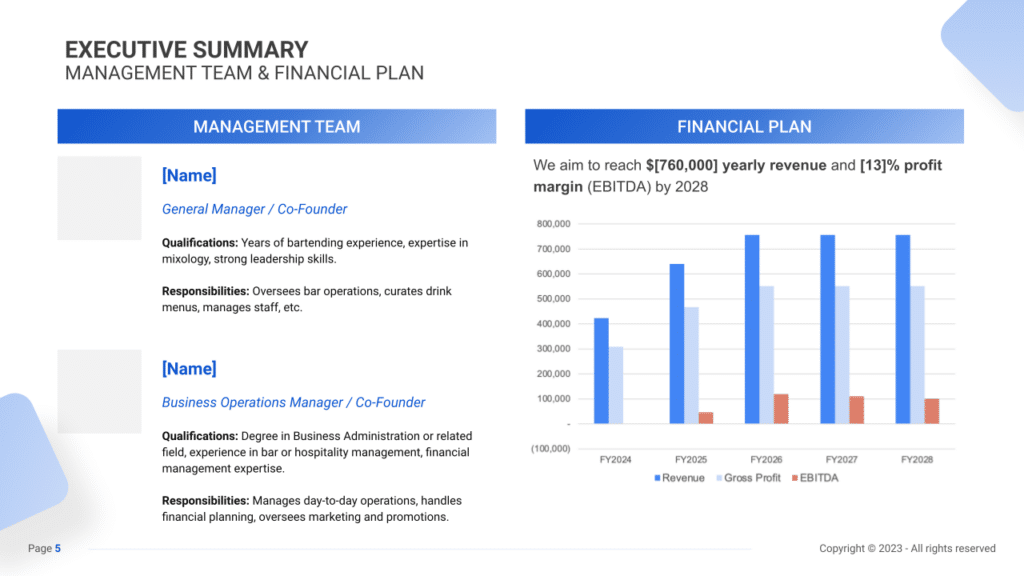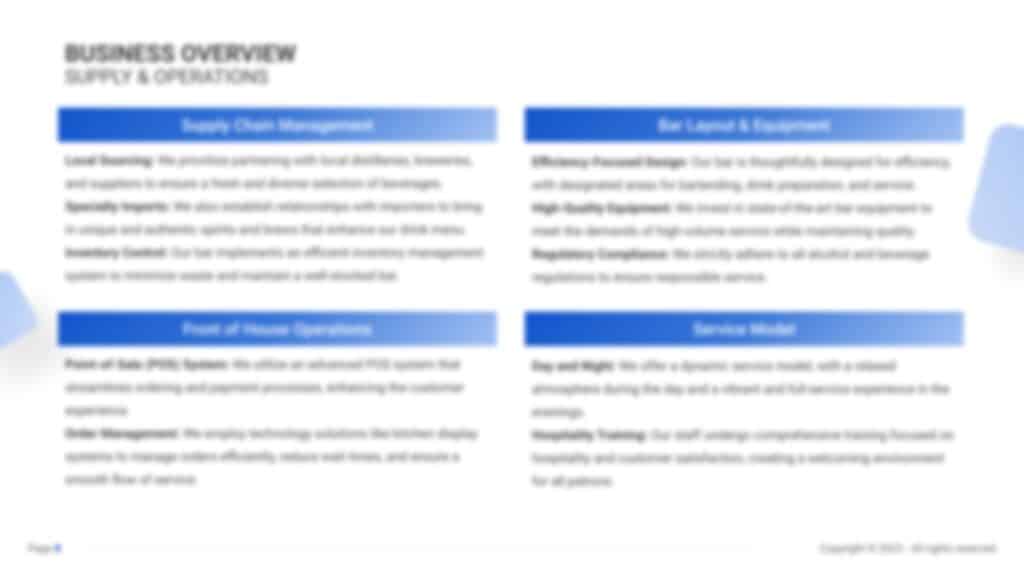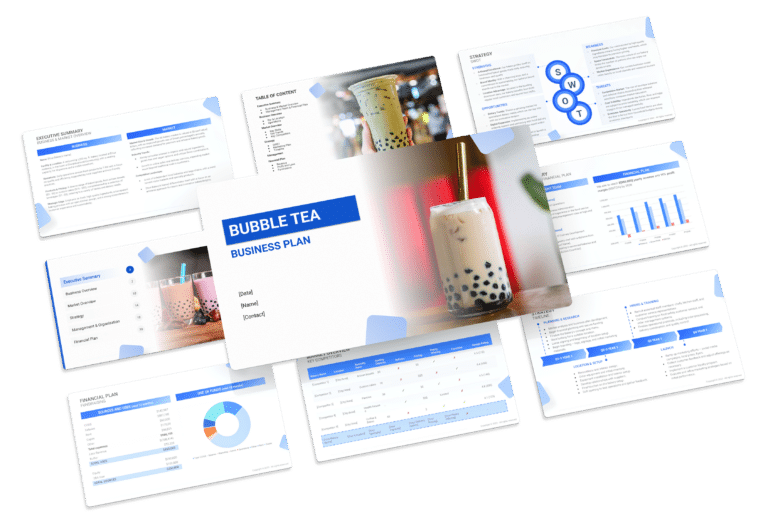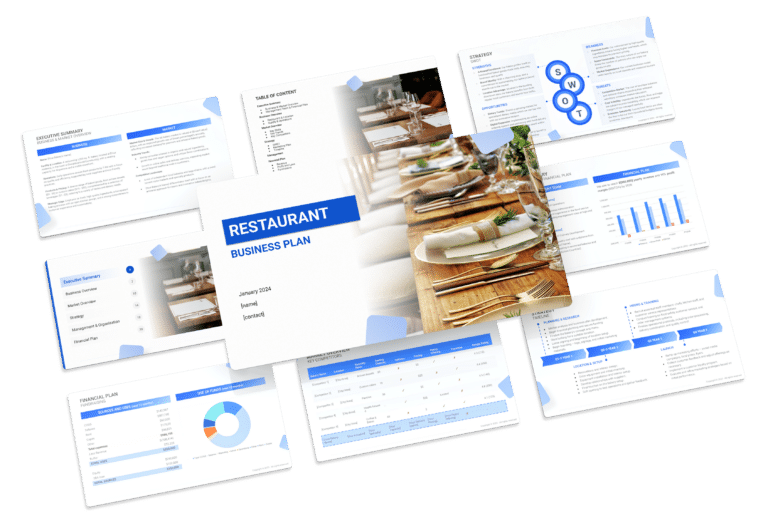Bar Business Plan Template & PDF Example

Creating a comprehensive business plan is crucial for launching and running a successful bar business. This plan serves as your roadmap, detailing your vision, operational strategies, and financial plan. It helps establish your bar business’s identity, navigate the competitive market, and secure funding for growth.
This article not only breaks down the critical components of a bar business plan but also provides an example of a business plan to help you craft your own.
Whether you’re an experienced entrepreneur or new to the food & beverage industry, this guide, complete with a business plan example, lays the groundwork for turning your bar business concept into reality. Let’s dive in!
The Plan
Our bar business plan is structured to encompass all critical elements necessary for a detailed and effective strategy. It outlines the bar’s operations, including the types of beverages and the food we will offer, the ambiance and theme of the bar, and any unique features or services that set us apart from competitors, such as live music, themed nights, or craft cocktail offerings.
- Executive Summary: Offers an overview of your Bar’s business concept, including the unique selection of beverages, market analysis, management team, and financial strategy.
- Business Overview: Provides detailed information on what your Bar offers and its operational model:
- Bar & Location: Describes the bar’s strategic location, ambiance, and seating capacity, offering a welcoming environment for guests to enjoy their favorite drinks.
- Supply & Operations: Details the bar’s supply chain for premium spirits and beers, inventory management, and operational efficiency to ensure a high-quality customer experience.
- Market Overview: Examines the bar industry landscape, identifies competitors and how your bar stands out:
- Key Stats: Shares industry size, growth trends, and relevant statistics for the bar market.
- Key Trends: Highlights recent trends affecting the bar sector, such as the popularity of craft and artisanal beverages, and the integration of technology for enhanced customer experiences.
- Key Competitors: Analyzes main competitors in your area and how your bar differentiates itself, focusing on your unique selling propositions like specialty drinks, entertainment options, or ambiance.
- Strategy: Outlines how the Bar intends to achieve growth and attract clients:
- SWOT: Strengths, weaknesses, opportunities, and threats analysis tailored to the bar business.
- Marketing Plan: Strategies for promoting your bar and attracting customers, including social media engagement, local partnerships, and hosting special events.
- Timeline: Key milestones and objectives from the initial setup through the first year of operation and beyond.
- Management: Information on who manages the Bar, detailing their roles, experience in the beverage industry, and business management.
- Financial Plan: Projects the bar’s 5-year financial performance, including revenue from beverage sales, profit and loss statements, cash flow analysis, and balance sheet, aiming for significant growth and profitability by the target year.

Executive Summary
The Executive Summary introduces your bar’s business plan, offering a concise overview of your establishment and its offerings. It should detail your market positioning, the range of beverages, food items, and entertainment services you offer, its location, size, and an outline of day-to-day operations.
This section should also explore how your bar will integrate into the local market, including the number of direct competitors within the area, identifying who they are, along with your bar’s unique selling points that differentiate it from these competitors.
Furthermore, you should include information about the management and co-founding team, detailing their roles and contributions to the bar’s success.
Additionally, a summary of your financial projections, including revenue and profits over the next five years, should be presented here to provide a clear picture of your bar’s financial plan.
Bar Business Plan Executive Summary Example


Business Overview
The business overview within your executive summary acts as the gateway to acquainting your audience with fundamental details about your bar. Elements such as the establishment’s name, location, and a glimpse into its daily operations serve as introductory notes. Yet, the crux lies in articulating your unique selling proposition (USP), delineating the factors that differentiate your bar from the competition.
Example:
Consider “The Night Owl Lounge,” situated in the heart of downtown. Spanning across 2,000 square feet, this bar offers an inviting ambiance for patrons seeking a blend of sophistication and relaxation. The Night Owl Lounge stands out by curating an exquisite range of craft cocktails crafted by expert mixologists, focusing on locally sourced ingredients to create distinctive flavors in a sustainable environment.
Market Overview
A robust understanding and presentation of market dynamics is integral to this section. It’s imperative to illustrate the scope, growth trends, and industry shifts. Data-driven insights portraying the value and expansion rates of the U.S. bar and nightclub industry are paramount. Additionally, shedding light on industry trends such as the surge in demand for craft beverages and experiential entertainment underscores your bar’s relevance within the evolving landscape.
Example:
The Night Owl Lounge operates in the thriving U.S. bar and nightclub industry valued at $36 billion. Within a vibrant market boasting approximately 67,500 similar establishments, the lounge capitalizes on evolving trends by offering an immersive experience centered on craft cocktails, locally sourced ingredients, and a sustainable ethos, standing as a unique proposition amid diverse competitors.
Management Team
The backbone of any successful venture lies in its management. Highlighting the expertise and qualifications of your management team in your executive summary exudes credibility and competence. Emphasize the backgrounds, experiences, and unique skill sets of key team members, offering a glimpse into the powerhouse driving your bar’s success.
Example:
At The Night Owl Lounge, [Name], a seasoned professional with a degree in Business Administration and a wealth of experience in bar and hospitality management, leads the helm. [Name] oversees daily operations, financial planning, and spearheads marketing initiatives, ensuring a seamless and prosperous venture.
Financial Plan
Concluding the executive summary with a succinct financial plan overview anchors the narrative of your bar’s projected financial journey. Precise yet comprehensive insights into revenue targets, profit margins, and growth strategies provide a clear trajectory of your bar’s fiscal aspirations.
Example:
The Night Owl Lounge aims for a projected annual revenue of $1 million by the third operational year, targeting a 15% EBITDA margin. This financial roadmap incorporates strategic investments in maintaining an upscale bar atmosphere and innovative marketing campaigns, aimed at fostering community engagement, propelling the lounge towards profitability and local recognition within a five-year span.
Business Overview
For a Bar, the Business Overview section can be effectively divided into 2 main slides:
Bar & Location
Briefly describe the bar’s physical environment, focusing on its design, ambiance, and the overall atmosphere that invites patrons.
Furthermore, mention the bar’s location, emphasizing its accessibility and the convenience it offers to patrons, such as proximity to entertainment districts or ease of parking. Explain why this location is strategic in attracting your target clientele.
Supply & Operations
Detail the range of beverages offered, from craft beers and fine wines to specialty cocktails and non-alcoholic options. Outline your operations strategy, including the sourcing of ingredients, the management of inventory, and maintaining quality control.
Discuss your pricing strategy, ensuring it reflects the quality of offerings and aligns with the market you’re targeting. Highlight any special events, happy hour deals, or loyalty programs that provide added value to your patrons, encouraging repeat visits and customer loyalty.


Market Overview

Industry size & growth
In the market overview of your bar business plan, start by examining the size of the bar and nightlife industry and its growth potential. This analysis is essential for understanding the market’s scope and identifying opportunities for expansion.
Key market trends
Proceed to discuss recent market trends, such as the increasing consumer interest in craft beers, artisanal cocktails, premium spirits, and unique beverage experiences. For example, highlight the demand for bars that offer specialty drinks, themed nights, and immersive experiences, alongside the rising popularity of bars that focus on sustainability and locally sourced ingredients.
Competitive Landscape
A competitive analysis is not just a tool for gauging the position of your bar in the market and its key competitors; it’s also a fundamental component of your business plan. This analysis helps in identifying your bar’s unique selling points, essential for differentiating your business in a competitive market.
In addition, competitive analysis is integral in laying a solid foundation for your business plan. By examining various operational aspects of your competitors, you gain valuable information that ensures your business plan is robust, informed, and tailored to succeed in the current market environment.
Identifying Your Bar’s Competitors
Begin by identifying both direct and indirect competitors within your locality. Direct competitors might include other bars or lounges offering similar services, cocktails, and entertainment. Indirect competitors could encompass restaurants with bars, nightclubs, or even entertainment venues hosting occasional events.
Utilize online tools like Google Maps to survey the geographic spread of these competitors and review platforms like Yelp or TripAdvisor for customer insights, which can reveal competitor strengths and weaknesses. For instance, glowing reviews praising the mixology expertise and vibrant ambiance at “MixMasters Lounge” can highlight a key strength of your competitor.

Bar Competitors’ Strategies
Analyze the strategies implemented by your competitors, focusing on various facets:
- Drink Offerings: Assess the range and uniqueness of their drink menu. If “Crafty Cocktails” nearby is gaining traction for its inventive mixology and craft beer selection, it indicates a trend towards artisanal beverages.
- Atmosphere and Theme: Consider the ambiance and theme. A bar like “Retro Vibes” with a nostalgic setting might attract a different clientele compared to a modern and trendy establishment like “Fusion Lounge.”
- Pricing and Promotions: Compare pricing strategies. Are your prices in line with the affordable offerings at “Happy Hour Haven” or more aligned with the premium rates of “Luxury Libations”?
- Marketing Strategies: Evaluate their marketing tactics. Do competitors heavily invest in social media marketing, events, or collaborations, or do they rely on traditional advertising methods?
- Customer Experience: Assess the overall experience offered. For instance, “Relaxation Station” might excel in providing a cozy ambiance and personalized service, enhancing the customer experience.
- Operational Efficiency: Observe the use of technology or innovative processes. Bars like “TechSavvy Spirits” might leverage mobile apps for ordering and reservations, streamlining customer service.
What’s Your Bar’s Value Proposition?
Reflect on your bar’s unique value proposition. Perhaps your bar specializes in bespoke cocktails using locally sourced ingredients, or it may offer a thematic experience that resonates with a specific customer segment.
Identify market gaps through customer feedback and industry trends. For instance, the rising demand for alcohol-free or low-alcohol options could represent an underserved market if competitors aren’t catering to this segment.
Consider your location: A bar in a bustling downtown area might focus on happy hour promotions and after-work gatherings, while one in a residential neighborhood could emphasize community events or live music nights to attract locals.
Strategy

SWOT
First, conduct a SWOT analysis for the bar, highlighting Strengths (such as a unique selection of beverages, a prime location, and exceptional customer service), Weaknesses (including potential high operational costs, licensing restrictions, or strong competition), Opportunities (for example, a growing interest in craft beers and artisanal cocktails, or the potential for hosting special events), and Threats (such as changes in regulatory environments or economic downturns that may reduce discretionary spending on nightlife).

Marketing Plan
Next, develop a marketing strategy that outlines how to attract and retain patrons through targeted advertising, promotional discounts, an engaging social media presence, themed events, and community involvement. Consider loyalty programs or partnerships with local businesses to broaden your customer base.
Marketing Channels
Effectively utilizing marketing channels is crucial to increasing brand visibility and attracting patrons to your bar.
Digital Marketing
In today’s digital age, establishing a robust online presence is imperative for reaching and engaging with potential customers:
- Social Media: Utilize platforms like Instagram, Facebook, and Twitter to showcase your bar’s ambiance, special events, drink specials, and behind-the-scenes glimpses. Engage with followers through contests, polls, and user-generated content.
- Email Marketing: Build an email list by offering exclusive deals or event invites. Send regular newsletters featuring upcoming events, mixology tips, or stories behind signature drinks.
- Website and SEO: Develop a user-friendly website highlighting your drink menu, event calendar, and ambiance. Optimize it for local SEO to ensure high visibility in searches related to bars in your area.
Local Advertising
Supplement your online efforts with targeted local advertising strategies to reach potential customers within your vicinity.
- Flyers and Local Print: Distribute visually appealing flyers in local hotspots, offices, and community boards. Advertise in local newspapers or magazines that align with your bar’s atmosphere.
- Events and Partnerships: Host or sponsor local events, live music nights, or themed parties. Collaborate with nearby businesses or artists for cross-promotional opportunities.
Promotional Activities
Engage potential patrons with appealing offers and loyalty programs.
- Special Deals and Events: Introduce happy hours, themed nights, or drink specials like ‘Mixology Mondays’ or ‘Craft Beer Showcases’ to attract new customers and retain regulars.
- Loyalty Programs: Implement a loyalty system where frequent visitors can earn rewards, such as a free drink after a certain number of visits or exclusive access to events.
- Referral Incentives: Encourage patrons to bring friends by offering rewards or discounts for referrals that result in new customers.

Sales Channels
Effectively managing sales channels within your bar can optimize revenue opportunities and enhance customer satisfaction.
Upselling and cross-selling
- Service Add-Ons: Train your staff to upsell premium or complimentary drinks, appetizers, or specials when taking orders. Offering suggestions for drink pairings or upsizing options can enhance the customer experience while increasing sales.
- Merchandising: Display branded merchandise such as glassware, apparel, or cocktail kits strategically within your bar. Offering these items for sale can serve as additional revenue streams while reinforcing your brand identity.
- Private Events and Reservations: Promote and cater to private events, including birthdays, corporate gatherings, or special celebrations. Create tailored packages and offer exclusive amenities to make these events memorable, thereby attracting group reservations and fostering repeat business.
Online Booking and Sales
- Online Booking System: Implement an efficient online booking system for table reservations, event tickets, or private party inquiries. Ensure a seamless booking experience across your website and social media platforms to facilitate easy access for customers.
- E-Commerce: Consider selling bar merchandise, gift cards, or exclusive event tickets through your website. Providing an online platform for purchasing merchandise or gift cards can extend your brand’s reach beyond the physical bar location.
Membership and VIP Programs
- Membership Options: Develop exclusive membership or VIP programs that offer perks such as priority seating, discounts on purchases, access to private events, or personalized experiences. Encouraging regular patrons to enroll in these programs can foster loyalty and repeat business.
- Loyalty Rewards Program: Implementing a digital loyalty program is an excellent way to reward customers for their continued patronage and incentivize repeat visits. Design a system where customers earn points for every dollar spent at your bar.
Strategy Timeline
Finally, create a detailed timeline that outlines critical milestones for the bar’s opening, marketing efforts, patron base growth, and potential expansion objectives, ensuring the business moves forward with clear direction and purpose.

Management
The Management section focuses on the bar business’s management and their direct roles in daily operations and strategic direction. This part is crucial for understanding who is responsible for making key decisions and driving the bar business towards its financial and operational goals.
For your bar business plan, list the core team members, their specific responsibilities, and how their expertise supports the business.


Financial Plan
The Financial Plan section is a comprehensive analysis of your financial projections for revenue, expenses, and profitability. It lays out your bar business’s approach to securing funding, managing cash flow, and achieving breakeven.
This section typically includes detailed forecasts for the first 5 years of operation, highlighting expected revenue, operating costs, and capital expenditures.
For your bar business plan, provide a snapshot of your financial statement (profit and loss, balance sheet, cash flow statement), as well as your key assumptions (e.g. number of customers and prices, expenses, etc.).
Make sure to cover here
_ Profit and Loss
_ Cash Flow Statement
_ Balance Sheet
_ Use of Funds









